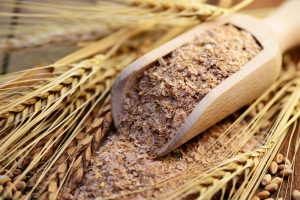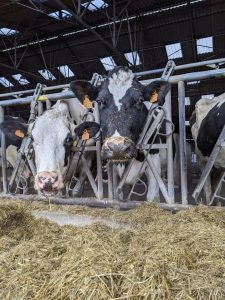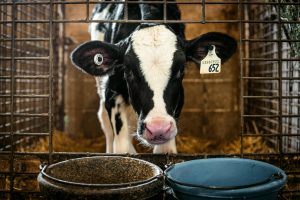John K. Bernard
The amount of information available for forage sorghum is not as abundant as for corn silage or alfalfa. However, the available data does provide a good background for estimating how the forage could be used for feeding dairy cattle. This article will examine the nutrient content of forage sorghum and results of recent feeding trials at our dairy.
Nutrient Content
The nutrient content of a forage provides a good starting point for examining how a forage could be used as part of a feeding program. Chemical composition of corn, silage, BMR (Brown MidRib) corn silage, and forage sorghum silage submitted to the Cumberland Valley Analytical Laboratory from producers in the Southeast, Plains, and Western US during 2015 through 2019 are summarized in Table 1. These samples in each category reflect how the samples were labelled when received by the laboratory for analysis, so the results are not 100% accurate as there were most likely mislabeled samples. However, the data does reflect the expected differences among these three forages based on more controlled data bases. The energy concentrations (NEl) were calculated using crude protein, NDF, lignin, crude fat, and ash values from each sample.
Table 1. Chemical composition of silage, corn silage, BMR corn silage, and forage sorghum silage
| Item | Corn silage | BMR corn silage | Forage sorghum silage |
| Number of samples | 62,669 | 6 | 6,982 |
| DM, % | 36.3 | 35.5 | 32.5 |
| Protein, % of DM | 8.02 | 7.73 | 9.92 |
| Soluble Protein, % protein | 51.7 | 37 | 50.3 |
| ADF, % of DM | 25.3 | 25.2 | 35.8 |
| NDF, % of DM | 40.6 | 42.2 | 54.3 |
| Lignin, % of DM | 3.14 | 2.45 | 4.97 |
| NDF 30 h, % of NDF | 55.9 | 65.8 | 52.5 |
| Soluble fiber, % of DM | 5.65 | 8.03 | 4.38 |
| Sugar, % of DM | 1.47 | 2.93 | 3.68 |
| Starch, % of DM | 31.1 | 28.7 | 10.1 |
| Crude fat, % of DM | 3.1 | 2.66 | 2.89 |
| Ash, % of DM | 4.79 | 4.86 | 10.2 |
| NEl, Mcal/lb | 0.74 | 0.74 | 0.61 |
Compared with corn silage, forage sorghum had lower concentrations of DM and starch, but higher concentrations of protein, fiber (NDF y ADF), lignin, sugar, and ash. Good corn silage is approximately 50% grain accounting for the differences in composition. Because of that, the energy concentration of normal forage sorghum is approximately 82% of corn silage.
There were a limited number of BMR corn silage samples in the data set. The BMR corn silage had lower concentrations of protein, lignin and starch, but the 30-hour NDF digestibility was 65.8 % compared with 55.9% for normal corn silage. The calculated energy value was not different from corn silage because the differences in NDF digestibility are not considered in the equation. The data base also included a category for BMR sorghum forage, but the DM concentrations (47.7 ± 28.5%) reflected forage that had been wilted indicating that the data included other forages in the sorghum family. Chemical analysis reported from published research trials indicate that BMR forage sorghum has lower lignin concentrations compared with normal forage sorghum that allow greater NDF digestibility. The calculated energy value is also lower and does not reflect the high fiber digestibility associated with the BMR genetics, so more emphasis should be placed on actual nutrient content and digestibility than the calculated energy value when comparing BMR and normal varieties.
Production response
Results from several trials have been reported in the literature. In general, diets based on normal forage sorghum support lower milk yield and slightly higher milk fat percentage than those based on corn silage. As such, if corn silage is available it is preferentially fed to fresh and higher producing cows and the normal forage sorghum is better suited for mid to late lactation cows that are not limited by intake. Normal forage sorghum silage also works well for dry cows and heifers.
We have conducted two trials examining the use of brachytic dwarf BMR forage sorghum compared with corn silage. In South Georgia, we can plant and harvest two corn crops for silage and the forage sorghum can be allowed to regrow after the first harvest providing a second harvest. The results of the first trial are summarized in Table 2 (Bernard and Tao, 2015). Diets were formulated for mid-lactation Holsteins with 38% of the DM provided by either corn silage or the BMR forage sorghum plus oat baleage. Because of the higher fiber content of the BMR forage sorghum, slightly less baleage and more ground corn was fed compared with the corn silage diets. No differences were observed in DM intake, milk yield or yield of milk components. Milk fat percentage was higher for cows fed the BMR forage harvested in the fall whereas lactose percentage was lower when cows were fed corn silage from the summer harvest. Concentrations of milk urea nitrogen (MUN) were higher for cows fed diets based on the BMR forage sorghum which is consistent with previous research. The results of our second trial (Bernard and Tao, 2017) were similar except that milk fat yield was higher for cows fed diets based on BMR forage sorghum.
Table 2. Dry matter intake (DMI), milk yield and composition of cows fed diets based on corn (CS) or forage sorghum (FS) silage harvested in the summer (S) or fall (F).
| Item | Treatment | |||||
| CSS | CSF | FSS | FSF | P | ||
| DMI, kg/d | 21.4 | 23.1 | 22.6 | 21.1 | 0.57 | |
| Milk, kg/d | 32.2 | 33.4 | 32.9 | 33.5 | 0.92 | |
| Fat, % | 3.20a | 2.91a | 3.42b | 3.53b | 0.02 | |
| Fat, kg/d | 1.03 | 0.97 | 1.12 | 1.18 | 0.14 | |
| Protein, % | 2.80 | 2.70 | 2.64 | 2.69 | 0.15 | |
| Protein, kg/d | 0.90 | 0.90 | 0.87 | 0.90 | 0.93 | |
| Lactose, % | 4.63a | 4.88b | 4.87b | 4.82b | 0.01 | |
| Lactose, kg/d | 1.49 | 1.63 | 1.60 | 1.61 | 0.78 | |
| ECM, kg/d | 30.8 | 30.4 | 31.9 | 33.1 | 0.64 | |
| Efficiency, ECM/DMI | 1.44 | 1.32 | 1.41 | 1.57 | 0.55 | |
| MUN, mg/dl | 10.6a | 13.4a | 14.9b | 15.3b | 0.01 | |
ab Means in the same row with unlike superscripts differ (P < 0.05).
More recently we conducted a trial in which we compared diets containing 32.6% corn silage and 20.6% of silage from either BMR forage sorghum or BMR pearl millet for mil-lactation Holstein cows (Bernard and Tao, 2020). The diets were formulated to provide similar concentrations of protein and fiber. No differences were observed in intake, milk yield or composition except for MUN which was higher for cows fed the diets based on BMR forage sorghum.
Table 3. Intake and production response of mid-lactation Holsteins fed diets supplemented with pearl millet silage (PMS) or forage sorghum silage (FSS) during week 4 to 6.
| Item | PMS | FSS | P |
| DMI, kg/d | 26.3 | 26.5 | 0.89 |
| Milk, kg/d | 36.1 | 36.9 | 0.44 |
| Fat, % | 3.42 | 3.48 | 0.63 |
| Fat, kg/d | 1.23 | 1.28 | 0.73 |
| Protein, % | 2.78 | 2.78 | 0.95 |
| Protein, kg/d | 1.00 | 1.03 | 0.63 |
| Lactose, % | 4.79 | 4.72 | 0.09 |
| Lactose, kg/d | 1.73 | 1.74 | 0.79 |
| ECM, kg/d | 35.5 | 36.5 | 0.69 |
| Efficiency, ECM/DMI | 1.35 | 1.38 | 0.77 |
| MUN, mg/dl | 14.27 | 16.72 | < 0.001 |
Implications
Forage sorghum silage can be used as the primary forage or as part of a forage system for feeding lactating dairy cows. Normal forage sorghum has less energy compared to corn silage or BMR forage sorghum. However, the higher fiber digestibility of BMR forage sorghum provides more energy that can support similar yield of milk and components as corn silage, but will require more ground corn or similar starch source. Most research has examined BMR forage sorghum in mid to late lactation cows, so information on feeding early lactation cows is limited. Higher MUN concentrations are consistently observation from trials in which either normal or BMR forage sorghum was fed compared with corn silage and is possibly due to differences in fermentable rates of fiber in the rumen that do not allow better utilization of the degradable protein provided by forage sorghum. The decision to grow normal or BMR forage sorghum should be based primarily on agronomic factors including rainfall patterns or availability of water for irrigation, how it fits into the current planting and harvesting schedule, and other factors that are more specific to your land and operation.
About the author
Dr. John K. Bernard is a professor in the Department of Animal and Dairy Science at the University of Georgia Tifton Campus. He has a research and extension appointment in dairy nutrition and management. His applied research program addresses issues related to forages, by-products, specialty ingredients, additives and heat stress. During his career, Dr. Bernard has published more than 100 referred publications and numerous extension bulletins and newsletters. In addition to his academic responsibilities, John provides oversight of daily operations and budgets of the dairy, beef and farm units at Tifton. jbernard@uga.edu
References:
- Bernard, J.K., Tao, S. 2015. Short communication: Production response of lactating dairy cows to brachytic forage sorghum silage compared with corn silage from first or second harvest. J. Dairy Sci. 98:8994-9000.
- Bernard, J.K., Tao, S. 2017. Effect of brachytic dwarf forage sorghum or corn silage harvested in the summer or fall and supplemented with soybean meal or mechanically pressed cottonseed meal on performance of lactating dairy cows. Prof. Anim. Sci. 33:342-348.
- Bernard, J.K., Tao, S. 2020. Lactating dairy cows fed diets based on corn silage plus either brown midrib forage sorghum or brown midrib pearl millet silage have similar performance. Appl. Anim. Sci. 36:2-7.
© 2020 Dairy Knowledge Center, LLC. All Rights Reserved.









